WBR0572: Difference between revisions
Jump to navigation
Jump to search
No edit summary |
YazanDaaboul (talk | contribs) No edit summary |
||
| Line 1: | Line 1: | ||
{{WBRQuestion | {{WBRQuestion | ||
|QuestionAuthor={{Rim}} | |QuestionAuthor={{Rim}} (Reviewed by {{YD}}) | ||
|ExamType=USMLE Step 1 | |ExamType=USMLE Step 1 | ||
|MainCategory=Pathophysiology | |MainCategory=Pathophysiology | ||
| Line 21: | Line 21: | ||
|MainCategory=Pathophysiology | |MainCategory=Pathophysiology | ||
|SubCategory=Neurology | |SubCategory=Neurology | ||
|Prompt=A 35-year-old | |Prompt=A 35-year-old man presents with a one-month history of progressive weakness in his upper extremities. The patient initially had difficulty moving his right arm but was then complaining of inability to move both arms. He also reports stuttered speech and some occasional twitching in his arms. The patient works as a lawyer and has been lately frustrated because of his symptoms. Physical examination of the upper extremities reveals bilateral fasciculation, proximal muscle atrophy, and weakness that is more pronounced in the right upper extremity than in the left. Rigidity is noted upon attempting to passively extend the patient’s arms. Sensory neurological examination is unremarkable in both upper and lower extremities. Babinski sign is positive bilaterally. Based on the clinical history and physical examination findings, which of the following images correlates with the site of the neurological lesion in the patient (lesion in red)? | ||
|Explanation= | |Explanation=Amyotrophic lateral sclerosis (ALS or Lou Gehrig disease) is a progressive neurodegenerative disorder of the central and peripheral motor systems. The hallmark of ALS is the presence of signs and symptoms that suggest the simultaneous involvement of upper motor and lower motor neuron disease. Notably, ALS does not affect the sensory, cognitive, or oculomotor nervous systems. Manifestations of ALS vary, and symptoms may suggest prognosis and progression. Presentations may have a limb-onset, bulbar-onset, or less commonly pure upper/lower motor neuron involvement. Patients may develop of limb spasticity, weakness, fasciculations, wasting, and hyperreflexia. In addition, bulbar symptoms may include spastic dysarthria that causes distorted nasal speech, flaccid dysarthria, brisk gag/jaw jerks, or dysphagia. This patient has signs and symptoms consistent with ALS. Fasciculations and muscle atrophy are signs of lower motor neuron involvement, whereas rigidity, hyperreflexia marked by a positive Babinski test, and stuttered speech are signs of upper motor neuron involvement. Weakness in his extremities may be signs of either upper or lower motor neuron involvement. The cause of ALS is unknown, but some have speculated a role of superoxide dismutase 1 defects in the pathogenesis of the disease. The majority of patients with ALS die within 30 months of onset of symptoms, and less than 20% survive beyond 5 years. The management of ALS is very limited, riluzole has demonstrated modest improvement in survival among ALS patients. | ||
|AnswerA=[[Image: | |AnswerA=[[Image:WBR0570A.gif|300px]] | ||
|AnswerAExp=This image illustrates a lesion in the central cord depicting [[syringomyelia]] | |AnswerAExp=This image illustrates a lesion in the central cord depicting [[syringomyelia]]. | ||
|AnswerB=[[Image: | |AnswerB=[[Image:WBR0570B.gif|300px]] | ||
|AnswerBExp=This image depicts asymmetric lesions in the white matter, which | |AnswerBExp=This image depicts asymmetric lesions in the white matter, which are characteristic of [[multiple sclerosis]]. | ||
|AnswerC=[[Image: | |AnswerC=[[Image:WBR0570C.gif|300px]] | ||
|AnswerCExp=This image depicts lesions in the dorsal columns | |AnswerCExp=This image depicts lesions in the dorsal columns consistent with tabes dorsalis due to tertiary syphilis. | ||
|AnswerD=[[Image: | |AnswerD=[[Image:WBR0570D.gif|300px]] | ||
|AnswerDExp=This image depicts lesions in the anterior horn of the [[spinal cord]] | |AnswerDExp=This image depicts lesions in the anterior horn of the [[spinal cord]] characteristic of poliomyelitis. | ||
|AnswerE=[[Image: | |AnswerE=[[Image:WBR0570E.gif|300px]] | ||
|AnswerEExp=This image depicts lesions in the white matter and grey matter. | |AnswerEExp=This image depicts lesions in the white matter and grey matter. This pattern of lesions is typical of [[ALS]], where patients present with symptoms of upper and lower motor neuron involvement. | ||
|EducationalObjectives=ALS is a progressive | |EducationalObjectives=ALS is a progressive neurodegenerative disorder characterized by involvement of upper and lower motor neuron systems. In the spinal cord, ALS is caused by lesions that typically involve the white and grey matters. | ||
|References=First Aid 2014 page 467 | |References=Kiernan MC, Vucic S, Cheah BC, et al. Amyotrophic lateral sclerosis. Lancet. 2011;377:942-55.<br> | ||
First Aid 2014 page 467 | |||
|RightAnswer=E | |RightAnswer=E | ||
|WBRKeyword=Spinal cord, ALS | |WBRKeyword=Spinal cord, ALS, Upper motor neuron, Lower motor neuron, Motor, Neurodegenerative, Neurodegenerative disease, Neurodegenerative disorder, Idiopathic, Riluzole | ||
|Approved= | |Approved=Yes | ||
}} | }} | ||
Revision as of 17:09, 15 October 2014
| Author | [[PageAuthor::Rim Halaby, M.D. [1] (Reviewed by Yazan Daaboul, M.D.)]] |
|---|---|
| Exam Type | ExamType::USMLE Step 1 |
| Main Category | MainCategory::Pathophysiology |
| Sub Category | SubCategory::Neurology |
| Prompt | [[Prompt::A 35-year-old man presents with a one-month history of progressive weakness in his upper extremities. The patient initially had difficulty moving his right arm but was then complaining of inability to move both arms. He also reports stuttered speech and some occasional twitching in his arms. The patient works as a lawyer and has been lately frustrated because of his symptoms. Physical examination of the upper extremities reveals bilateral fasciculation, proximal muscle atrophy, and weakness that is more pronounced in the right upper extremity than in the left. Rigidity is noted upon attempting to passively extend the patient’s arms. Sensory neurological examination is unremarkable in both upper and lower extremities. Babinski sign is positive bilaterally. Based on the clinical history and physical examination findings, which of the following images correlates with the site of the neurological lesion in the patient (lesion in red)?]] |
| Answer A | [[AnswerA::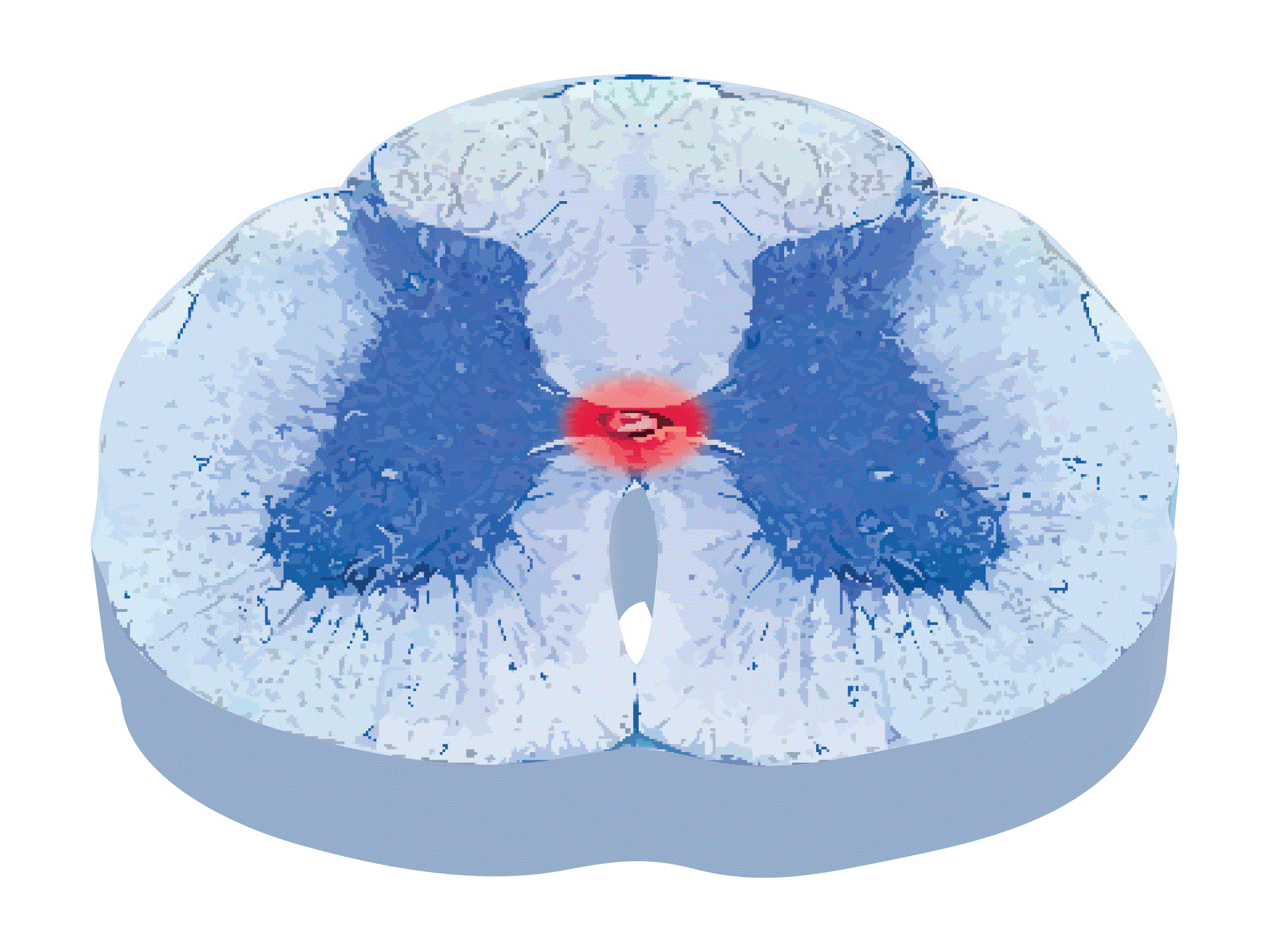 ]] ]]
|
| Answer A Explanation | [[AnswerAExp::This image illustrates a lesion in the central cord depicting syringomyelia.]] |
| Answer B | [[AnswerB::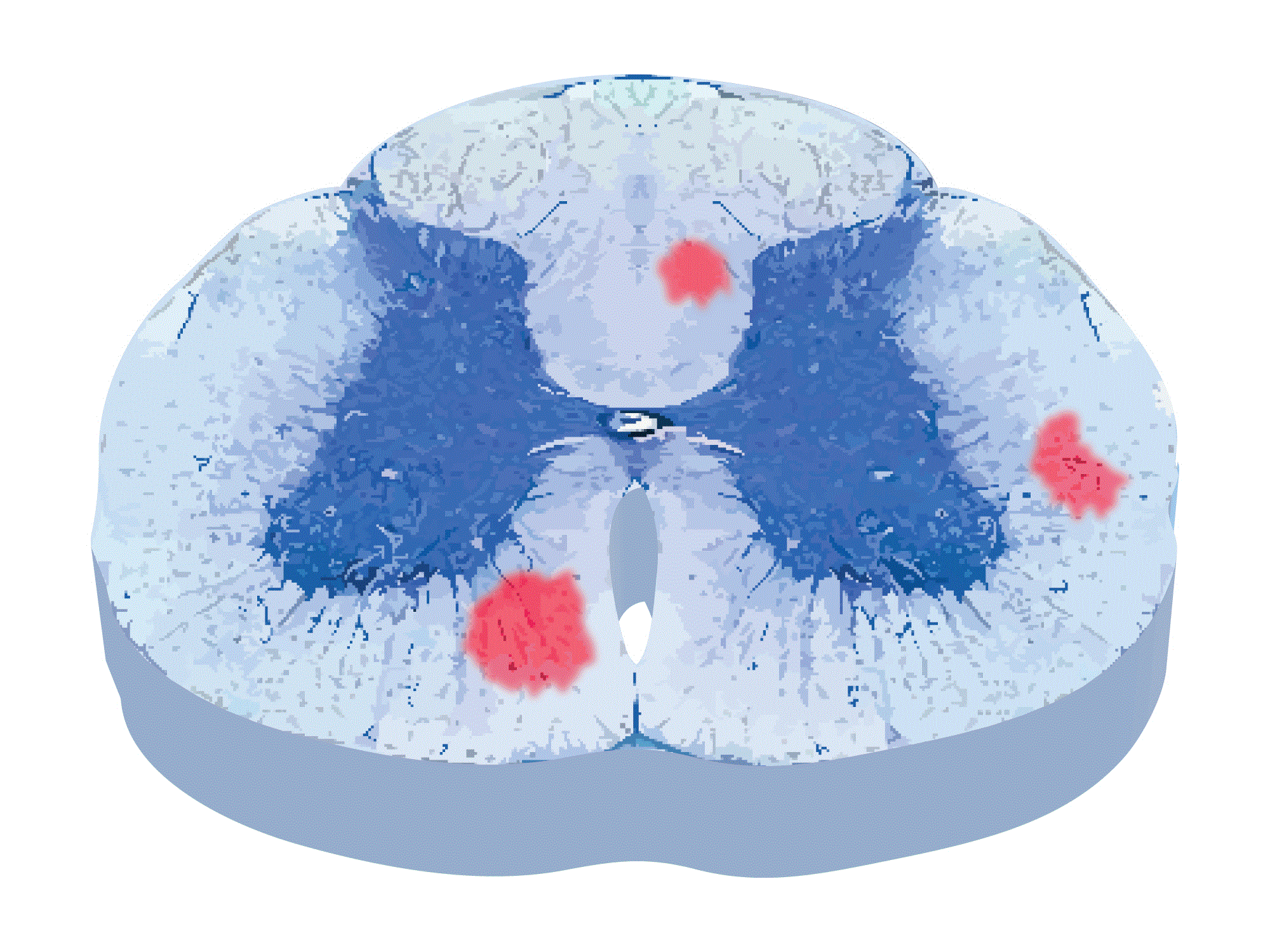 ]] ]]
|
| Answer B Explanation | [[AnswerBExp::This image depicts asymmetric lesions in the white matter, which are characteristic of multiple sclerosis.]] |
| Answer C | [[AnswerC::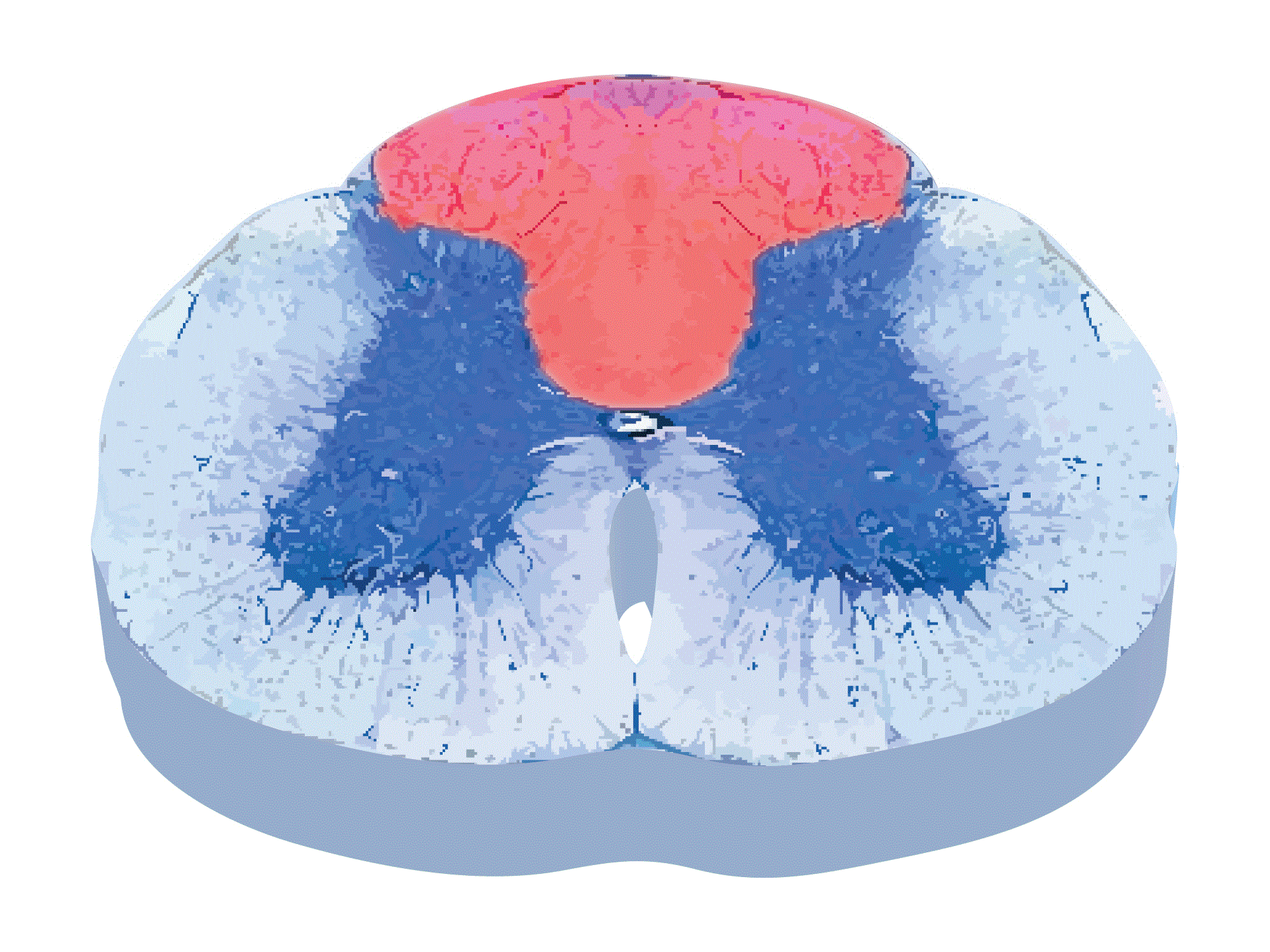 ]] ]]
|
| Answer C Explanation | AnswerCExp::This image depicts lesions in the dorsal columns consistent with tabes dorsalis due to tertiary syphilis. |
| Answer D | [[AnswerD::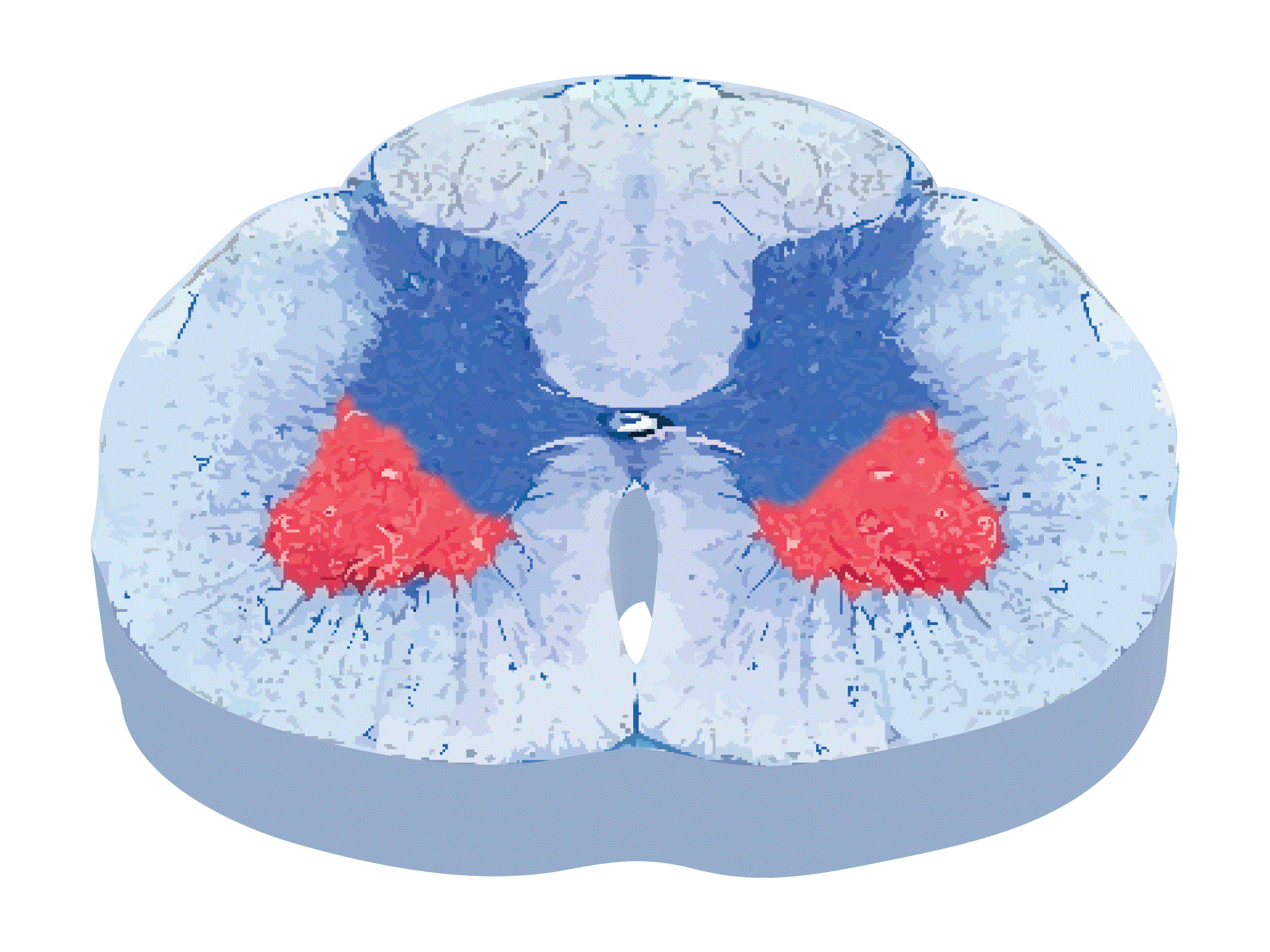 ]] ]]
|
| Answer D Explanation | [[AnswerDExp::This image depicts lesions in the anterior horn of the spinal cord characteristic of poliomyelitis.]] |
| Answer E | [[AnswerE::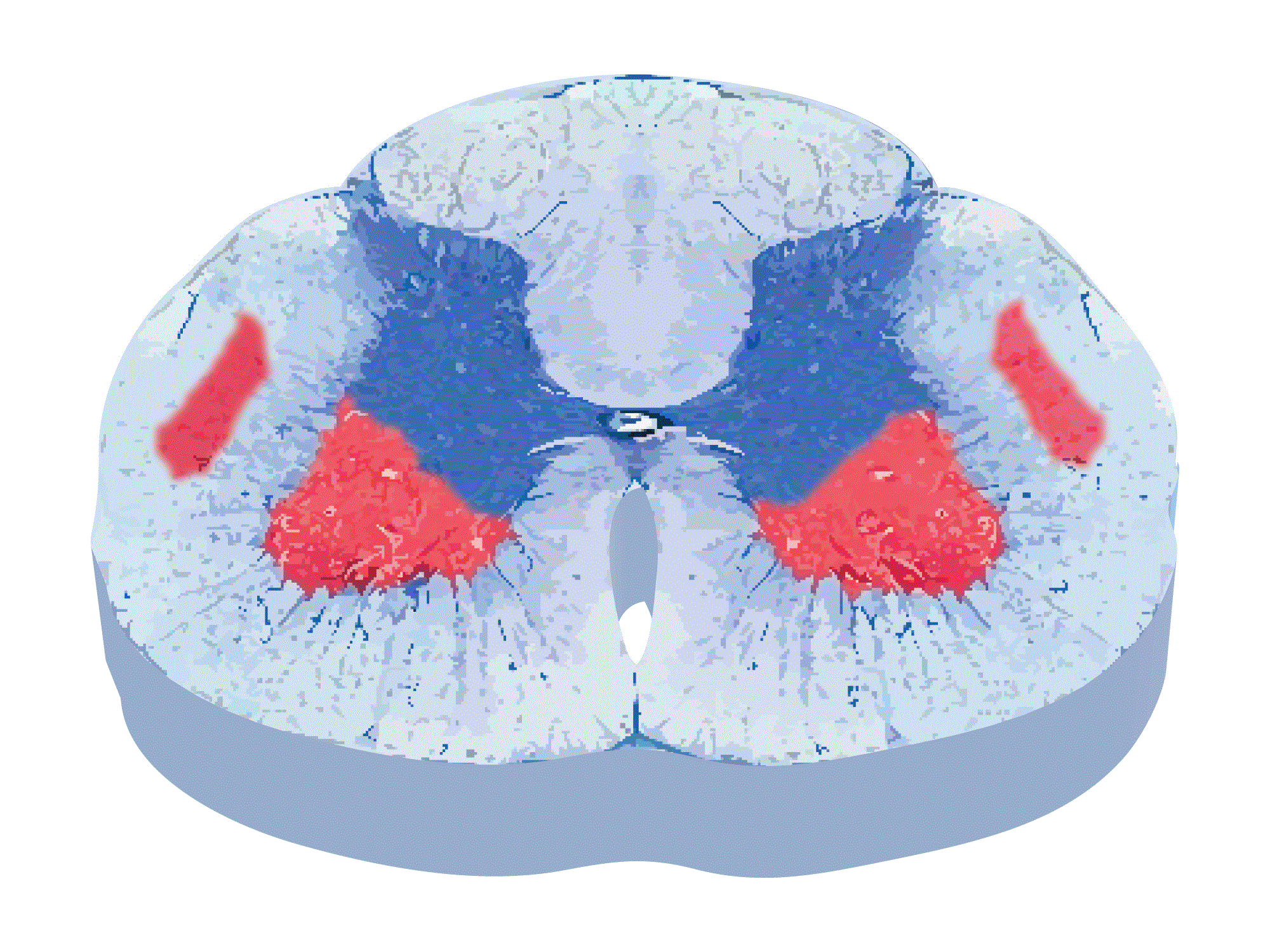 ]] ]]
|
| Answer E Explanation | [[AnswerEExp::This image depicts lesions in the white matter and grey matter. This pattern of lesions is typical of ALS, where patients present with symptoms of upper and lower motor neuron involvement.]] |
| Right Answer | RightAnswer::E |
| Explanation | [[Explanation::Amyotrophic lateral sclerosis (ALS or Lou Gehrig disease) is a progressive neurodegenerative disorder of the central and peripheral motor systems. The hallmark of ALS is the presence of signs and symptoms that suggest the simultaneous involvement of upper motor and lower motor neuron disease. Notably, ALS does not affect the sensory, cognitive, or oculomotor nervous systems. Manifestations of ALS vary, and symptoms may suggest prognosis and progression. Presentations may have a limb-onset, bulbar-onset, or less commonly pure upper/lower motor neuron involvement. Patients may develop of limb spasticity, weakness, fasciculations, wasting, and hyperreflexia. In addition, bulbar symptoms may include spastic dysarthria that causes distorted nasal speech, flaccid dysarthria, brisk gag/jaw jerks, or dysphagia. This patient has signs and symptoms consistent with ALS. Fasciculations and muscle atrophy are signs of lower motor neuron involvement, whereas rigidity, hyperreflexia marked by a positive Babinski test, and stuttered speech are signs of upper motor neuron involvement. Weakness in his extremities may be signs of either upper or lower motor neuron involvement. The cause of ALS is unknown, but some have speculated a role of superoxide dismutase 1 defects in the pathogenesis of the disease. The majority of patients with ALS die within 30 months of onset of symptoms, and less than 20% survive beyond 5 years. The management of ALS is very limited, riluzole has demonstrated modest improvement in survival among ALS patients. Educational Objective: ALS is a progressive neurodegenerative disorder characterized by involvement of upper and lower motor neuron systems. In the spinal cord, ALS is caused by lesions that typically involve the white and grey matters. |
| Approved | Approved::Yes |
| Keyword | WBRKeyword::Spinal cord, WBRKeyword::ALS, WBRKeyword::Upper motor neuron, WBRKeyword::Lower motor neuron, WBRKeyword::Motor, WBRKeyword::Neurodegenerative, WBRKeyword::Neurodegenerative disease, WBRKeyword::Neurodegenerative disorder, WBRKeyword::Idiopathic, WBRKeyword::Riluzole |
| Linked Question | Linked:: |
| Order in Linked Questions | LinkedOrder:: |